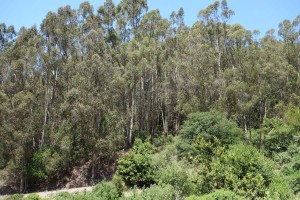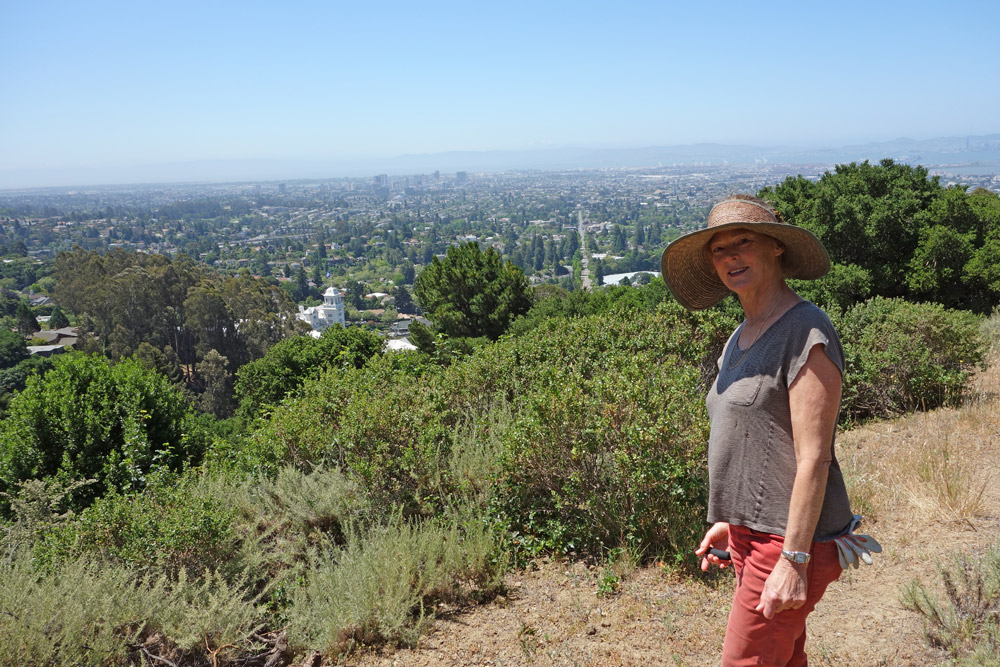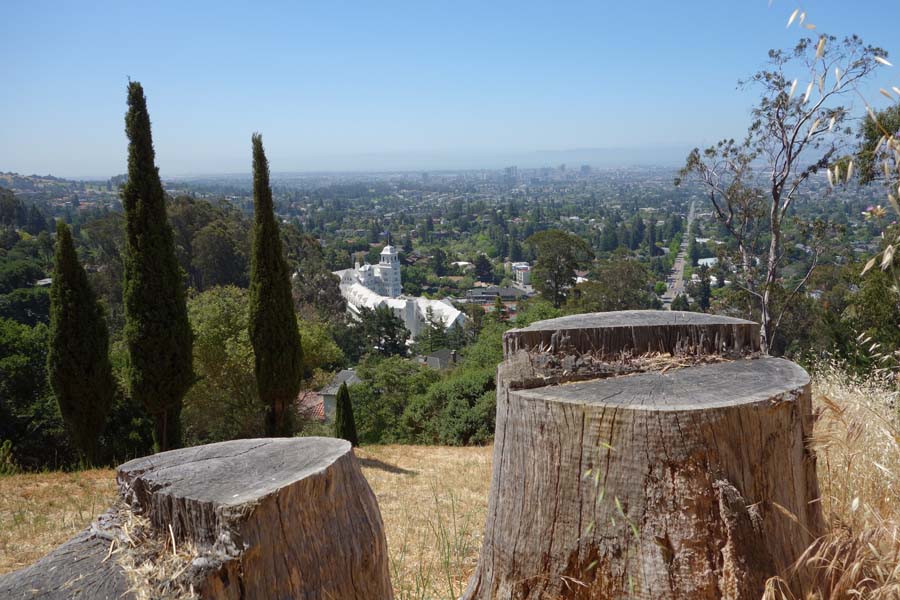Last week, a post on the news website BeyondChron.org lit up our corner of the internet: it popped up in emails, on Facebook, and on Twitter with a scathing review of a proposal to remove nonnative trees from hundreds of acres scattered across the East Bay Hills.
For many local residents, especially those who arrived after the 1991 East Bay firestorm, the proposal seemed to come out of nowhere. Most people who lived through that fire or who live in the hills know this particular proposal has been a decade and more in the making, and the debate over fuels reduction in the hills goes back at least 20 years.
The image of clear-cut hillsides and hundreds of gallons of herbicides raining down on the “currently pristine hills” brought people out in droves. A public meeting at Claremont Middle School attracted a standing-room only crowd, and most speakers were critical of the plan.
Whatever one thinks of the current plans, it’s important to remember that the East Bay hills are anything but pristine: Native grasslands were almost entirely replaced by invasive grasses centuries ago. Eucalyptus plantations took over open oak woodlands. We built golf courses and houses and roads and planted all kinds of exotic trees and ivy and blackberry.
And, every so often, the warm, dry Diablo Winds blow from the east and a lot of that stuff burns.

Now, the Federal Emergency Management Authority is in the final stages of reviewing a fire management plan that covers a thousand acres in a patchwork stretching from Richmond to San Leandro.
That’s a lot of land, but much of the debate has focused on Claremont Canyon, and to a lesser degree Strawberry Canyon, where all the public entities involved — UC Berkeley, the East Bay Regional Park District (EBRPD), and the City of Oakland — own land. These canyons are also nearest where the 1991 fire started.
“We are smaller scope in terms of fire management,” says Tom Klatt, who manages the work for UC Berkeley, “But we are in one of the most critical areas. We have the two undeveloped canyons that run east to west and are most vulnerable in Diablo wind conditions.”
Those are winds that blow from east to west, bringing hot, dry air with them, producing conditions where any wildfire is likely to spread like, well, wildfire.
A key premise is that habitats with more native plants — oak-bay woodlands, chaparral, and grasslands (all of which co-evolved with fire) — are more fire-safe than are fairly dense forests of eucalyptus and pine. A second premise is that the way to bring those habitats back is to aggressively remove nonnative trees across large areas, and then follow up for ten years with treatments (including herbicides) to kill any returning invasives.
As I tried to get a handle on this, I realized that there simply is no short version of this story.
So I decided to talk not just to Tom Klatt, but also to four other people with unique perspectives on the place and the plan. So we hear from a biologist, a neighbor and gardener, a historian and retired park manger, a skeptic, and Klatt, a key project manager.
The Biologist

Lech Naumovich, who runs the Golden Hour Restoration Institute, was the conservation analyst for the East Bay chapter of the California Native Plant Society and now he does consulting work for various agencies and nonprofits, including EBRPD and the Claremont Canyon Conservancy.
“There’s a lot of assumptions in these documents about how fires start, how they develop, how they become really extreme crown fires,” says Naumovich, referring to the 3,500-page Environmental Impact Statement.
Naumovich worries that when large sums of money are spent on massive removal projects, the grassroots education component gets neglected, and it’s during grassroots projects that many people learn about how defensible space around their own homes can effectively keep neighborhoods from burning.
“The number one thing is for people to take care of their own backyards,” he says. “People are out in the parks weeding and then they start talking about things they’ve done in their own yards. These bigger projects that are done by contractors, they are impersonal, and you lose a lot of that educational component. That’s why I value the grassroots: people interact and have conversations.”
He particularly singled out the work at Oakland’s Garber Park (which we covered in 2011) and restoration around Stonewall Road in Berkeley.
“The nice thing about the sequential project over there by Stonewall is that people are involved in helping maintain it,” he explains. “It’s not a one and done, [like another site up the canyon]: It was a one and done and you’re left with six feet of mulch on the ground.”
The Gardener


At the top of Stonewall Road, just about every day, you can find Marilyn Goldhaber tending the hillside above her house, pulling out thistle and broom to make way for natives, including the large swathes of sticky monkeyflower that were in bloom when I visited.
Full disclosure: Goldhaber and her husband, Nat, are donors to Bay Nature Institute. She’s also been quite active with the Claremont Canyon Conservancy, which strongly supports the FEMA grants and the large-scale removal of eucalyptus.
One of the worries about such tree removal is that other weeds like broom and thistle might invade and take over.
That’s not happening on Goldhaber’s watch in this one area, anyway. The park district removed eucalyptus here a number of years ago, and then Goldhaber has worked out agreements that allow her to do her work here on parts of Claremont Canyon Regional Park.
“There’s an element of trust, but once you build that trust, they’re happy to have the help,” she said.
Naumovich was hired by the Claremont Canyon Conservancy to assess vegetations management activities at two locations in the canyon, and he singled out the hillside behind Goldhaber’s home as a pattern to follow.
“We were inspired by the richness and diversity of this managed coastal scrub,” he wrote in his final report. “This area should serve as a model.”
But that means a commitment to ongoing work by park neighbors.
“It’s minutes at a time, so it’s not huge,” she says. “But it is every day.”
As we walked, she pulled a few broom seedlings and told me how after the district cleared and burned brush here, she meticulously pulled 100 broom seedlings at a time, five days a week. “I figured I personally pulled 10,000 broom seedlings.”
The Historian

When I asked retired EBRPD manager, East Bay historian, and Claremont Canyon Conservancy board member Jerry Kent for his take on the situation, he was happy to talk. But he also made sure to send me an article in progress called “The Blue Gum Quandary,” in which, among other things, he chronicled all the major known plantings of eucalyptus in the region, starting in 1853.
And he reminded me that one of the key areas for removal, the forest on the north side of Claremont Avenue beyond Garber Park, was not exactly the product of those original plantings. Instead, a long, hard freeze in 1972 killed thousands of those original trees. The standing dead stems were removed, but eucalyptus are notoriously persistent in stump sprouting, so new trees grew up from the stumps of the old. These new trees are thinner, denser, and often not so structurally sound.
On the south side of Claremont Avenue, the post-freeze eucalyptus have been removed, and other trees and shrubs have moved in. But the eucalyptus on the north side remain.
“The Claremont Canyon Conservancy has worked with the university for about 10 years removing eucalyptus suckers, and the end result is a nice bay-oak woodland with some redwoods that were planted there,” Kent says. “You can see a before and after there. The after is on the south side of the road as you are driving up, and the current is on the north side.”
To Kent, the FEMA environmental documents represent the state of the art for fire and fuels management.
“The hills have been probably the most studied area in California since the ’91 fire. No other area in California has had that kind of intense study. The [EIS] recommends a move toward native vegetation that’s less flammable and less costly.”
The Skeptic

Dan Grassetti, who leads the Hills Conservation Network and lives in the canyon, has his own view of whether native vegetation is less flammable.
“It’s a bad idea to mix the native and nonnative discussion with fire risk,” he says. “Some folks seem to have decided that because something is native, the fire risk must be acceptable. But this is about fire risk, not about native plant restoration. FEMA intended these funds for fire-risk mitigation.”
He’d like to see the forests cleared of understory vegetation and debris that can serve as ladder fuels, which then can ignite the crowns of the trees and turn a small fire into an unstoppable inferno.
“We have an unnatural situation here,” he says. “There should be small fires burning through the understory on a regular basis, but because we won’t let that happen, we have this massive buildup of ground fuel.”
To him then, the height and mass of eucalyptus is an advantage: if ladder fuels are removed and trees are “limbed up,” then it’s much less likely that a fire will jump from the ground into the crown. He even goes so far as to say that native bay trees, which don’t grow nearly as tall as eucalyptus, might be more fire-prone, because more of their small, flammable leaves and branches are close to the ground.
“The crown on a eucalyptus is very high. And what percentage of a bay tree is fine fuels? What percentage is at or near ground level?” he asks. “If you choose to vilify bay trees, you could do that too.”
Grassetti says he sees a “personal philosophy” at work in the proposed projects that simply favors native vegetation, and he disagrees with that philosophy. “Native is great, but there’s nothing to say that native are an acceptable fire risk and nonnative isn’t.”
The Project Manager

Tom Klatt has been in charge of eucalyptus removal and fuels management for UC Berkeley for more than a decade, and he doesn’t see himself particularly as a native plant advocate.
“We’re not really in the native stewardship business,” he says. “I started this as a disaster planner. It’s primarily focused on fire safety. But to get a project approved, you have to have consultations with many, many regulatory agencies, and they’ll each have their concerns. The removal of eucalyptus is probably the most beneficial from U.S. Fish and Wildlife’s perspective. It’s removal is seen as a 100 percent net benefit.”
[Editor’s note: The following paragraph has been edited (as of May 28, 2013) to include more detail on eucalyptus as habitat.] I asked Klatt about habitat for raptors, but he doesn’t buy claims that eucalyptus can provide habitat for raptors, beyond an occasional perch: “Owls tend to gravitate toward snags, and the eucalyptus doesn’t rot in that way, and because the trees are so tall, you have a lot of sway in the top branches. As the trees come down, we inspect them for nests, and it’s not something we’ve seen. They do perch in them, but we just don’t see the nests in them.” I couldn’t find a survey of nesting in eucalyptus for Claremont Canyon, but Dan Suddjian did one for Monterey in 2004 and we mentioned that in our 2006 story on the good and bad of eucalyptus. Suddjian also notes that eucs aren’t ideal for cavity nesters, but he did find 59 species of birds nesting in eucalyptus, and 90 species that use the trees regularly for perching, roosting, and feeding. That’s a lot of birds. On the other hand, he found that bird species that favor oak woodlands and riparian areas lose out in the presence of densely planted eucalyptus. It’s hard to know how that plays one way or the other: some creatures will lose out, and some will benefit. But clearly removing eucs isn’t a 100 percent gain in habitat broadly considered.
Since Klatt started the work in 2001, he’s analyzed past failed efforts at eucalyptus removal and found that herbicide must be directly applied, “dribbled on” in his words, a thin ring around the stump (the cambium) within 180 seconds of a tree’s being cut down to prevent the regrowth of suckers.
“The intention is that in any area we touch, the eucalyptus, [Monterey] pine, and acacia will be extirpated,” he says. “In our most recent efforts, we’ve gradually come to the herbicide application design that’s been shown to be 95 percent effective in killing the trees the first time. If you do it right, it takes one or two ounces per tree for mortality.”
He also doesn’t have much patience for other approaches or claims that the projects don’t include enough follow-up.
“This thinning suggestion is frankly not a viable alternative. To get 20 to 30 foot space, you’d have to remove 80 to 90 percent of the trees, and the remainder would serve as a seedstock. We’d end up back where we started. The suggestion that we go in every year and rake up debris is not a viable alternative unless you’re some place like a parkland campground with flat terrain,” he says. “We’ve learned this lesson over and over again. You want to do your heavy removal one time. But that doesn’t mean you finished your action. Then you’re dealing with coppicing or resprouting of trees, and that goes on two or three times a year for a decade or as long as necessary.”
That’s where volunteers come in.
“You have to be in the area. We developed trail systems so volunteers can help us. The Claremont Canyon Conservancy has 600 households and they are actively working to help with monthly stewardship days. It’s really a partnership and it does take a while. Without that infusion of volunteer labor, it would be vastly more difficult and expensive. They are a major source of labor and eyes on the ground.”
What’s next?

FEMA is accepting public comment until June 17. Here are instructions on how to comment.
According to the timeline posted on the project website, a final EIS will be prepared this summer, followed by a final 30-day comment period and a record of decision, all by “summer 2013.”
And we’ll give Lech Naumovich the last word:
“If anything, I really applaud that there are some good discussions going on about our role in the landscape and stewardship. There are always fringe ideas out there, but there’s also a lot of good that comes of these conversations.”





